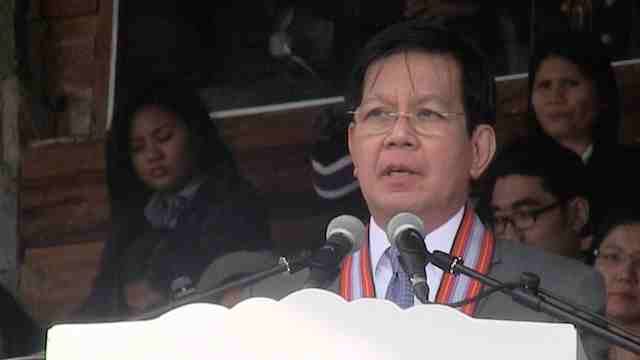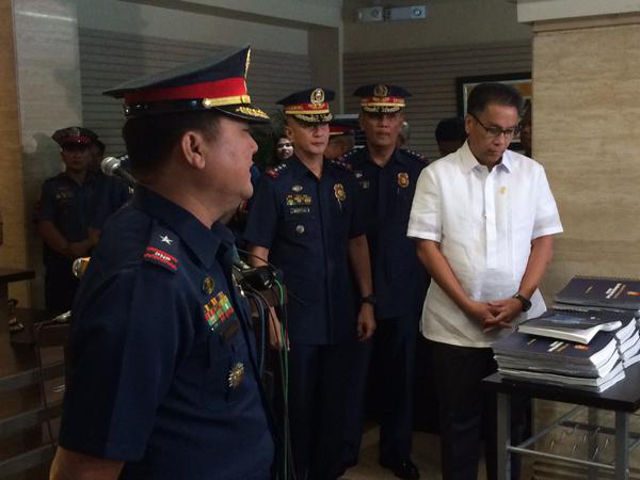SUMMARY
This is AI generated summarization, which may have errors. For context, always refer to the full article.

MANILA, Philippines – Former senator Panfilo Lacson took to social media to support the Philippine National Police Board of Inquiry (PNP-BOI) on its report on the Mamasapano incident, even as Malacañang criticizes its findings.
The BOI report cited the lapses of President Benigno Aquino III when he broke the PNP chain of command in the operation to hunt down international terrorist Zulkifli bin Hir, better known as “Marwan.”
Lacson, a police chief before he became senator, tweeted Saturday, March 14: “Art VII, Sec 18 of the 1987 Constitution states, ‘The President shall be the C-I-C of all armed forces…’ Isn’t the PNP an armed force?”
In a phone interview with Rappler on Sunday, Lacson said the President should instead explain why he had to go straight to SAF commander Director Getulio Napeñas instead of OIC police chief Deputy Director General Leonardo Espina.
Art VII, Sec 18 of the 1987 Constitution states, ‘The President shall be the C-I-C of all armed forces…’ Isn’t the PNP an armed force?
— Panfilo Lacson (@iampinglacson) March 14, 2015
@tatancast I’ll ask SOJ instead, why “C-I-C of all armed forces..” instead of “C-I-C of the AFP” if the Constitution refers only to the AFP
— Panfilo Lacson (@iampinglacson) March 14, 2015
“Dapat iyun ang i-explain ng Presidente. ‘Mayroon akong reason kung bakit I dealt directly with the director of SAF and not inform the OIC. Mayroon akong reason.’ Dapat ‘yun ang sinabi niya, hindi ‘yung hindi covered by chain of command ang PNP. That is a wrong proposition,” said Lacson.
(That is what the President should explain: ‘I have a reason why I dealt directly with the director of SAF and not inform the OIC. I have a reason.’ That is what he should have said, instead of arguing that the PNP is not covered by the chain of command. That is a wrong proposition.)
Aquino also ignored the suspension of his close friend police chief Director General Alan Purisima and allowed him to continue his participation in the operation. Purisima said he was only giving advice but Napeñas said he took them as orders.
Lacson posted his tweets after Justice Secretary Leila De Lima and Presidential Spokesperson Edwin Lacierda relied on legalese to defend Aquino after the release of the BOI report. They argued that the PNP is a civilian organization and thus doesn’t adhere to the concept of a chain of command that is strictly followed by the military.
Lacson disagreed. “How can it not be covered under the commander-in-chief provisions on all armed forces when [the PNP is an] armed force?” he told Rappler.
While the 1987 Constitution may be vague, he said the PNP has always observed a chain of command, including during his term as its chief. “We were covered by the chain of command. We called the President commander-in-chief. Even when I was chief PNP we recognized that,” Lacson said.
“I don’t see where they are coming from that the chain of command is only applicable to the Armed Forces of the Philippines (AFP). Masyadong restricted na yung interpretation ng chain of command,” Lacson added. (The intepretation of the chain of command is too restricted.)
The collapse of the chain of command was a central factor in the bungled SAF operations that killed not only Marwan on January 25, but also 44 elite cops, 18 fighters of the Muslim rebel group Moro Islamic Liberation Front (MILF), and 5 civilians. It is the bloodiest one-day security operation in the country’s recent history.
Lacson said there is nothing wrong if Aquino wanted to consult Purisima. The problem, however, is it appeared that Purisima was calling the shots. Aquino has put the blame on Napeñas who suposedly “tricked” him on the details of the operation in Mamasapano.
PNP was formed after 1987 Constitution
Lacson noted that the Constitution was drafted before the PNP was formed in 1991 to integrate the Philippine Constabulary and the Integrated National Police. The “armed force” in the Constitution was also written not in a generic way – in small letters – and could not only be referring to the AFP, he added.
“Ang 1987 Constitution, hindi ba maliwanag doon na the president shall be the commander-in-chief of all armed forces of the Philippines. ‘Yung armed forces doon hindi capital letters. Kapag sinabi mong Armed Forces of the Philippines, you refer to AFP. Kapag sinabi mong of all armed forces, ang PNP ba hindi armed force? ‘Yun ang point,” he said.
(The 1987 Constitution is clear that the president shall be the commander-in-chief of all armed forces of the Philippines. The term ‘armed forces’ isn’t in capital letters. When you say “Armed Forces of the Philippines,” you refer to the AFP. When you say “of all armed forces,” isn’t the PNP an armed force? That’s the point.)
“Otherwise, the Constitution should have said that the President is the commander-in-chief of the AFP if that is the intent,” he added.
In earlier tweets, Lacson hailed PNP Board of Inquiry and CIDG chief Police Director Benjamin Magalong and his team for doing their “job well.”
The BOI and the people behind it deserve commendation. They did their job well, without fear or favor and according to their sworn duty.
— Panfilo Lacson (@iampinglacson) March 13, 2015
A message to PDir Magalong: Your career ends when you retire; your character stays until the day you die. You can’t go wrong with the truth.
— Panfilo Lacson (@iampinglacson) March 14, 2015
Chain of command critical to PNP
The chain of command is critical to the PNP, Lacson said, because it goes hand in hand with the principle of unity of command.
“If there are two presidents and two chiefs of PNP, there is no unity of command…There will be confusion. There is a chain of command because it follows the principle of unity of command. There is only one commander at any level,” Lacson explained.
Lacson agreed with Malacañang that the President has the prerogative to go straight to a subordinate but this is only exercised during urgent missions. The BOI report also recognized this.
The hunt for Marwan is a continuing mission, however, that the SAF had obsessed itself with for years. It was also tackled in several meetings with Aquino before the operation was launched on January 24.
This is why the President should explain his actions, said Lacson.
Commander-in-chief and Chief Executive
Lacson said there should be no contradiction between the constitutional provision on the commander-in-chief powers of the President over the PNP and the Supreme Court ruling that De Lima cited in saying that the President is the chief executive of the PNP.
He said the President is both the commander-in-chief and the chief executive of the PNP. He functions as chief executive on matters involving executive functions. It is the same with his role as chief executive of the Department of National Defense (DND) and commander-in-chief of the Armed Forces of the Philippines, which is also under the DND.
The bungled SAF operation is the worst crisis to hit the Aquino administration so far. The January 25 clashes broke a carefully protected ceasefire with the MILF and imperilled the peace process that was previously gaining nationwide support.
Called “Oplan Exodus,” the BOI said the operation was “defective from the beginning” and was “poorly implemented”.

Lacson agreed. He scored Napeñas’ admission that he was expecting at least 10 fatalities. Lacson said that was unacceptable and the SAF should have gone back to the drawing board to fix the plan.
Critical lapses
The BOI report zeroed in on the lapses of Purisima and Napeñas, specifically their failure to properly coordinate with the military that has the assets that could have rescued the beleaguered SAF commandos. They also failed to use the ceasefire mechanism that could have avoided clashes with the MILF.
Napeñas also repeatedly stressed the need for operational security, saying he did not trust the military and the MILF.
The report noted that Napeñas was apparently counting on Purisima to make the coordination with the military, which is headed by his Philippine Military Academy (PMA) classmate General Gregorio Catapang Jr. The chief of the Western Mindanao Command is also a classmate.
“Ako na ang bahala kay Catapang (I will take care of Catapang),” Napeñas quoted Purisima telling him after a mission update for Aquino in Malacañang.
Malacañang maintained Aquino was only consulting Purisima and that he was getting updates from then SAF commander Napeñas.
Espina, Catapang, and Interior Secretary Manuel Roxas II were kept out of the loop. The SAF only informed the military when the operation was already underway and a firefight had erupted between the 55th SAF company and hostile forces in barangay Tukanalipao in Mamasapano.
The military said it could not fire its cannons to provide artillery support because it lacked the necessary details that would prevent possible collateral damage in an area inhabited by civilians. In spite of repeated denials, the report of the PNP-BOI claimed the peace process also prevented the military from going all out to rescue the SAF commandos. – Rappler.com
Add a comment
How does this make you feel?
There are no comments yet. Add your comment to start the conversation.